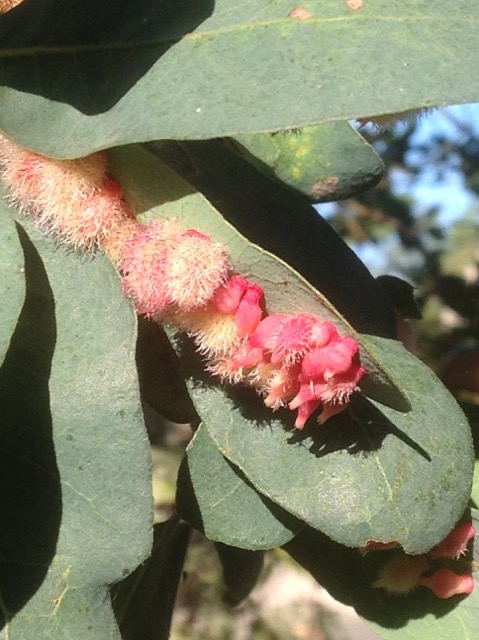Help for the Home Gardener from the
Help Desk of the Master Gardeners of Contra Costa County
Client's Question and Request: Hi, the pink fungus-like growth in the pictures below is spreading on my oak tree leaves. Can you advise? I have seen a little bit of this in the past, but this year it's really spreading fast; if you look at my tree from further away it is starting to have a pink cast, so there's a lot of this stuff! Thanks for any help you can give.


MGCC's Help Desk Response and Advice: Thank you for sending us the photos of your oak tree. What you are seeing are galls which are distorted, sometimes colorful swellings in plant tissue for which there are many causes such as wasps and other insects, fungi, nematodes, parasitic plants, etc.
The gall in your photos is one is one of the more spectacular galls seen in our oak woodlands and was recently observed in Hidden Lakes Park in Martinez. It is caused by an insect called a gall wasp which is about the size of a fruit fly. The wasp lays its eggs in the leaf. The developing larvae provide substances to induce the tree to form galls which provide shelter and food for the larvae. There are over 100 species of wasps associated with California oaks, and a species such as the Valley Oak or Blue Oak can have many different wasps associated with it. Each of these gall wasp species lays its eggs not only on specific parts of a tree, but also on certain species of oaks. For example, gall wasps associated with blue and valley oaks do not occur on coast and interior live oaks.
From your photo, it appears that your tree may be a Blue Oak (Quercus douglasi), in which case the Crystalline Gall Wasp (Andricus crystallinus) may be causing the galls you are seeing. The Iowa State University Bug Guide has photos of various galls, including that of the Chrystalline Gall Wasp which might help to confirm what you are seeing http://bugguide.net/node/view/145049/bgimage.
Your photo shows some galls which are fuzzy and some which are smooth. The UC publication "Oak Woodland Invertebrates" describes Chrystalline galls as pink to reddish, often densely covered with reddish or brownish hairs. And notes that if the larva of the gall fails to develop normally, possibly due to parasite attack, the fuzzy hairs are not produced and the galls remain bare. If you would like to bring a sample of your oak leaves with galls into our Help Desk office, we can look at them under the microscope and might be able to confirm which gall wasp species is on your tree.
While a few types of galls can cause limited leaf or twig die back by blocking the vascular tissue, most wasp galls cause little or no lasting damage to oaks. For more information on oaks and their insects and diseases, you might want to download a free pdf copy of the USDA publication titled "A Field Guide to Insects and Diseases of California Oaks" http://www.suddenoakdeath.org/pdf/psw_gtr197.pdf.
It is hard to believe that such a tiny insect is able to create so many galls on one tree! A recent issue of Bay Nature Magazine included an observation written by Ron Russo, retired Chief Naturalist for the East Bay Regional Park District, which highlights the magnitude and significance of such a tiny insect.
"On the east side of Briones Regional Park, in the late 1980s, I found a blue oak that stood about 30 feet high and looked quite healthy. But this tree supported a huge population of the cynipid wasp (Andricus kingi). Its red, cone-shaped galls covered every leaf that I could see–all the way up into the canopy, a dozen or more galls on each leaf. I calculated that a modest-size tree with 10,000 leaves could easily support 120,000 gall wasps of just this one species, excluding any other gall insects and their associates. Then by adding conservative ratios of gall parasites, hyperparasites (insects that attack parasites), and inquilines (insects that eat gall tissues, but will often kill any insects they confront inside the galls), I arrived at the astonishing number of just under 200,000 insects using one blue oak as a result of A. kingi galls and larvae. Even if these numbers are conservative and reached only during cycles when populations for a species are at their highest, perhaps once every five to 10 years, the ecological significance of a single blue oak–and blue oak woodlands–begins to come into focus."
You might want to monitor your oak tree and contact us again if you see significant twig die back. Otherwise, the galls are just part of nature.
Enjoy your tree.
Help Desk of the Master Gardeners of Contra Costa County
Note: The Master Gardeners of Contra Costa's Help Desk is available year-round to answer your gardening questions. Except for a few holidays, we're open every week, Monday through Thursday for walk-ins from 9:00 am to Noon at 75 Santa Barbara Road, 2d Floor, Pleasant Hill, CA 94523. We can also be reached via telephone: (925) 646-6586, email: ccmg@ucanr.edu, or on the web at http://ccmg.ucanr.edu/Ask_Us/